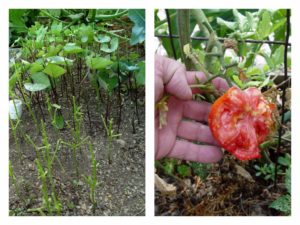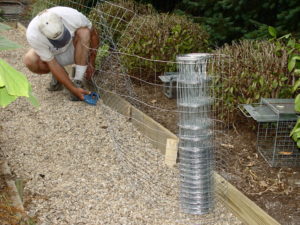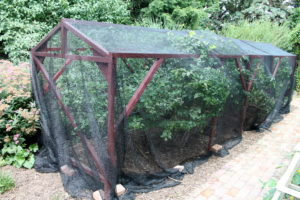How to Keep Animals from Eating Your Harvest
August 1st, 2017
Tomatoes, peppers, cucumbers, beans, squash, okra and all sorts of summer edibles should be maturing in droves in your garden by now, rewarding your springtime diligence.
But you might not be the only one vying for the harvest.
Animal pests assume you’ve kindly planted all of these tasty crops for them, and since they have nothing better to do all day than hunt for food, they often beat gardeners to the dining table.
Many a veteran gardener will tell you that overcoming animals is the hardest part of veggie gardening.
If we have an edge, it’s being able to outsmart them (sometimes). We also can buy or concoct assorted tricks and gizmos to protect our hard-earned harvest.
Here’s a look at some you might try:
Fencing
Rabbits can chew through plastic, so forget that fence material. Go with chicken wire, hardware cloth, or vinyl-coated metal.
The smaller openings you can find, the better. Baby bunnies can squeeze through inch-wide openings. Voles – those dark-brown, mouse-like rodents that are the most underrated, overlooked garden animal pest – can get through half-inch sizes.
Go at least 3 feet high. And assume rodents, rabbits and groundhogs will attempt to go under the fence if they can’t go through or over.
To stop that, bury boards 6 to 12 inches deep with an inch sticking above grade, then staple the fence to the top of the board. Or bury fencing 6 inches deep and 6 inches out to make an underground “apron” to discourage digging.
The C-fence
Groundhogs will defeat even the above Fort Veggie Knox because they can climb as well as dig. They’ll easily go up and over a 3-foot-tall fence – if it’s supported with the posts that most people use.
To overcome that, don’t secure the fence. Try using posts only at the corners so the fence is purposely flimsy and wobbly. When Mr. Groundhog tries to go up, his body weight pulls the fence back, and he can’t get over (usually).
Cages or spot-fencing
Sometimes, animals prefer young, tender shoots. Or they’re small enough that they can only eat young plants, such as newly emerged bean seeds or tomato transplants.
Add an extra measure of protection by wrapping cylinders of small-opening fencing or hardware cloth around young plants or newly seeded beds.
Two-liter soda bottles split vertically also can wrapped around young plants to make free “stem protectors.”
Netting
Squirrels are particularly hard to stop because they’re even better climbers than groundhogs. Birds – generally a gardener’s friend for eating bugs and singing so nicely – also do their share of food-stealing and damaging since they can easily swoop in from above.
Short of building a screened-in greenhouse, your only hope of getting ripe blueberries is to drape netting over your ripening bushes. That goes for other fruits that birds and/or squirrels also target, such as tomatoes, cherries, raspberries, blackberries, peaches and nut trees.
Skip thin, cheapie plastic netting and invest in something more durable. I’m using a pack I bought from the Gurney’s Nursery and Seed Co. catalog.
Birds can peck through thin netting, and it also tears easily after getting caught in branches.
Be sure to wrap or peg down the net bottoms so animals don’t sneak in underneath.
Repellents
You’ll find numerous brands of these in garden centers, usually made out of ingredients that are pungent, stinky or bitter-tasting (including urine from predator animals like fox and bobcat). Most of them work. The trick is that you have to apply them often enough to keep the scent fresh, such as after rains or every few weeks.
Use them around the garden and plants, not over edible parts, unless the product label says that’s OK and you wash them well anyway.
Also helpful is rotating different repellents so animals don’t get used to a smell and realize it’s a ruse.
Some gardeners make their own repellents out of ingredients such as rotten eggs, hot pepper sauce, garlic, ammonia, human hair, mint oils, etc. Recipes abound online.
Scare tactics
Some people set out radios or other noise-making devices to fake animals into thinking there’s ongoing human activity nearby. Depending where you live, that might be more annoying to neighbors than groundhogs.
I’ve tried gizmos such as plastic owls, scarecrows, ground-vibrating spikes, shiny Mylar tape, and hanging pie pans and old CDs, but none of them worked very well for long (if at all).
I’ve seen conflicting reports on the effectiveness of ultrasonic devices that supposedly make high-pitched sound that we and our cats and dogs can’t hear but that pest animals do.
One ploy that does work is a sprinkler attached to a motion-sensor device. When an object comes into the field, the water and accompanying racket turns in, startling the animal away.
One Perry County gardener I know solved his deer problem with one, and his garden’s damage aligned exactly with the range of the sprinkler. The down side is the potential for a supply-hose leak – and for you or your guests getting showered more often than the deer.
Traps
Lititz-based Woodstream Corp. makes the best-selling line of Havahart cage traps that come in a variety of sizes (not to mention all sorts of other animal-solving products).
Set the right-sized trap, bait it with a pest-favorite food, and the animal gets trapped inside after stepping on the trap door.
Chipmunks and groundhogs trap fairly easily, but it’ll take more perseverance to get voles and rabbits.
The big question is what do you do with the animal once it’s trapped? Rules vary on if and where you can release animals. Even if you can, it takes time, effort and gas to move them far enough away that they won’t just walk back to their favorite buffet (i.e. your garden).
Mouse snap-traps are effective for small rodents, if you’re not averse to killing them. (Note to animal activists: I’m not advocating it… just trying to give thorough and unbiased information to readers of varying viewpoints.)
Get a pet, preferably an ill-tempered one
Fight nature with nature by recruiting an animal of your own that has nothing better to do all day than hunt down other animals that have nothing better to do than eat your vegetables.
Groundhogs hate dogs… and the feeling is mutual. Sometimes the scent and barking alone are enough to get the job done. A vigilant enough dog may even keep deer away.
Cats are the mortal enemies of small rodents, especially voles, mice and chipmunks. They’re very adept at chasing them down… and they may even bring back dead carcasses to show you their hunting prowess.











